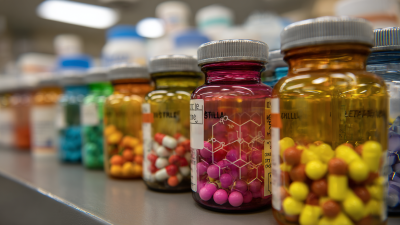Leave Your Message
Nitroxoline For Bacterial Infections has garnered increased attention in recent years, particularly in light of rising antibiotic resistance among common pathogens. According to a report from the World Health Organization, antibiotic resistance is responsible for approximately 700,000 deaths globally each year, a number projected to reach 10 million by 2050 if no effective measures are taken. Recent studies highlight the potential of nitroxoline, an antibacterial agent traditionally used to treat urinary tract infections, as a versatile alternative against a broader spectrum of bacterial infections. Its dual action—targeting both bacterial membranes and DNA—along with its relatively low propensity for promoting resistance, positions nitroxoline as a promising candidate in the search for effective treatments. This article delves into the mechanisms, efficacy, and recommendations for the optimal use of nitroxoline, providing a comprehensive guide for healthcare professionals looking to incorporate this drug into their antibiotic arsenal against resistant bacterial strains.

Nitroxoline, a nitrogen-containing hydroxyquinoline derivative, demonstrates potent antibacterial properties that make it effective against various bacterial infections. Its mechanism of action primarily involves the chelation of metal ions, disrupting essential enzymatic processes in bacterial cells. By binding to divalent metal ions, such as zinc and magnesium, Nitroxoline inhibits key enzymes involved in bacterial DNA synthesis and metabolism, ultimately leading to cell death.
Moreover, Nitroxoline's ability to disrupt the integrity of bacterial cell membranes further enhances its antibacterial effects. Recent studies indicate that the compound can interfere with the transport of essential substrates across the membrane, diminishing bacterial viability. This dual mechanism of action not only makes Nitroxoline effective against common pathogens but also suggests potential use in combination therapies to combat antibiotic resistance. Understanding these mechanisms is crucial for optimizing its clinical use and improving treatment outcomes for patients suffering from bacterial infections.

 Nitroxoline, a traditional antibiotic, has garnered renewed interest in recent clinical studies for its efficacy in treating bacterial infections. Recent research highlights Nitroxoline's effectiveness against a variety of pathogens, particularly in urinary tract infections (UTIs). Key studies demonstrate that Nitroxoline not only exhibits antibacterial properties but also helps in inhibiting biofilm formation, a common challenge in recurrent infections. This dual action makes it a compelling option for patients with stubborn bacterial infections.
Nitroxoline, a traditional antibiotic, has garnered renewed interest in recent clinical studies for its efficacy in treating bacterial infections. Recent research highlights Nitroxoline's effectiveness against a variety of pathogens, particularly in urinary tract infections (UTIs). Key studies demonstrate that Nitroxoline not only exhibits antibacterial properties but also helps in inhibiting biofilm formation, a common challenge in recurrent infections. This dual action makes it a compelling option for patients with stubborn bacterial infections.
Moreover, the clinical findings suggest that Nitroxoline can be particularly beneficial for patients with antibiotic resistance issues. As bacterial strains evolve, many existing antibiotics lose their effectiveness, leading healthcare professionals to seek alternative treatments. Nitroxoline's unique mechanism of action offers hope in combating resistant organisms, making it a valuable asset in contemporary medicine. These recent studies encourage further exploration into the broader applications of Nitroxoline, potentially reshaping treatment protocols for bacterial infections.
Nitroxoline, an established antibiotic, has shown considerable efficacy against various bacterial infections, particularly those of the urinary tract. Recent studies highlight its optimal dosage for different types of infections, ensuring both effectiveness and patient safety. For uncomplicated urinary tract infections, a common recommendation is 600 to 800 mg per day, divided into two or three doses. In cases of complicated infections, higher doses may be warranted, but careful monitoring is essential to mitigate potential side effects.
**Tips:** When using Nitroxoline, it's crucial to maintain hydration, as this aids in flushing out bacteria and enhances the drug’s effectiveness. Always adhere to prescribed dosages, as self-adjusting can lead to inadequate treatment or increased resistance. Furthermore, considering potential drug interactions, consulting with a healthcare provider before starting Nitroxoline is advisable, especially for patients on other medications.
For respiratory infections, recent guidelines suggest an initial dose of 600 mg, followed by adjustments based on clinical response and tolerability. Ensuring patients understand the importance of completing the course of treatment is vital in preventing recurrence and resistance. Regular follow-ups can help tailor the treatment plan, optimizing outcomes for those afflicted by bacterial infections.
Nitroxoline is an antibiotic commonly used for the treatment of bacterial infections, particularly those affecting the urinary tract. While it has shown effectiveness, potential side effects and contraindications must be carefully considered.
Common side effects include gastrointestinal disturbances such as nausea and vomiting, as well as headache and dizziness. Rarely, serious allergic reactions may occur, necessitating immediate medical attention. Patients should be aware of these possibilities to manage symptoms and seek help if needed.
Furthermore, certain populations should avoid Nitroxoline therapy due to potential contraindications. Individuals with a history of hypersensitivity to the drug or its components may experience severe adverse reactions. Additionally, patients with renal impairment should use this medication cautiously, as impaired kidney function can lead to increased drug accumulation and toxicity. Pregnant and breastfeeding women are also advised to consult their healthcare provider before initiating treatment, as the safety of Nitroxoline in such populations has not been fully established.
Awareness of these factors is crucial for optimizing treatment outcomes and minimizing risks during Nitroxoline therapy.
Recent studies have highlighted the potential of combining nitroxoline with other antibacterial agents to enhance its effectiveness against bacterial infections. Nitroxoline, a well-known synthetic antimicrobial, works primarily by disrupting bacterial enzyme functions. When used in tandem with other antibiotics, such as fluoroquinolones or beta-lactams, the synergistic effects can lead to enhanced bacterial inhibition, particularly against resistant strains. This combination therapy potentially reduces the dosage of each agent required, thereby minimizing side effects and lowering the likelihood of resistance development.
Furthermore, the strategic use of nitroxoline alongside probiotics is gaining attention as a method to maintain gut microbiota balance while combating infections. This approach not only targets the harmful bacteria but also supports the growth of beneficial ones, creating a more favorable environment for recovery. Incorporating nitroxoline in combination therapies can thus provide a multifaceted strategy against bacterial infections, making it an intriguing option for future clinical applications.
This chart illustrates the effectiveness of Nitroxoline when combined with other antibacterial agents in combating various bacterial infections. The data reflects recent studies highlighting the significant enhancement in antibacterial activity.






